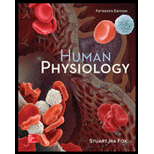
Human Physiology
15th Edition
ISBN: 9781259864629
Author: Fox, Stuart Ira
Publisher: Mcgraw-hill Education,
expand_more
expand_more
format_list_bulleted
Concept explainers
Question
Chapter 5, Problem 28RA
Summary Introduction
To review:
The process of
Introduction:
Different forms of nutrients are essential for various processes in the body. Nutrients such as carbohydrates, proteins, fats, minerals, and vitamins are obtained from different sources of food. Hydrolysis of carbohydrates releases monosaccharides such as glucose, which is the main substrate for energy production in the cells.
Expert Solution & Answer
Want to see the full answer?
Check out a sample textbook solution
Students have asked these similar questions
What is the label ?
Can you described the image? Can you explain the question as well their answer and how to get to an answer to an problem like this?
glg 112 mid unit assignment Identifying melting processes
Chapter 5 Solutions
Human Physiology
Ch. 5 - Define the term glycolysis in terms of its initial...Ch. 5 - What are the initial substrates and final products...Ch. 5 - Describe the physiological functions of lactic...Ch. 5 - Compare the fate of pyruvate in aerobic and...Ch. 5 - Draw a simplified citric acid cycle and indicate...Ch. 5 - Explain how NADH and FADH2 contribute to oxidative...Ch. 5 - Explain how ATP is produced in oxidative...Ch. 5 - Describe glycogenesis and glycogenolysis, and...Ch. 5 - Explain the significance of gluconeogenesis and...Ch. 5 - Prob. 6aCP
Ch. 5 - Prob. 6bCPCh. 5 - Describe transamination and deamination and...Ch. 5 - List five blood-borne energy carriers and explain,...Ch. 5 - Prob. 1RACh. 5 - In anaerobic metabolism, the oxidizing agent for...Ch. 5 - When skeletal muscles lack sufficient oxygen,...Ch. 5 - The conversion of lactic acid to pyruvic acid...Ch. 5 - Which of these statements about the oxygen in the...Ch. 5 - In terms of the number of ATP molecules directly...Ch. 5 - Ketone bodies are derived from
Ch. 5 - Prob. 8RACh. 5 - The conversion of glucose 6-phosphate to free...Ch. 5 - The formation of glucose from pyruvic acid derived...Ch. 5 - Which of these organs has an almost absolute...Ch. 5 - When amino acids are used as an energy source,
Ch. 5 - Intermediates formed during fatty acid metabolism...Ch. 5 - State the advantages and disadvantages of the...Ch. 5 - What purpose is served by the formation of lactic...Ch. 5 - Describe the effect of cyanide on oxidative...Ch. 5 - Describe the metabolic pathway by which glucose...Ch. 5 - Prob. 18RACh. 5 - Explain how energy is obtained from the metabolism...Ch. 5 - Prob. 20RACh. 5 - Why is the production of lactic acid termed a...Ch. 5 - Prob. 22RACh. 5 - What three molecules serve as the major substrates...Ch. 5 - A friend, wanting to lose weight, eliminates all...Ch. 5 - Suppose a drug is developed that promotes the...Ch. 5 - For many years, the total number of molecules of...Ch. 5 - People who are starving have very thin arms and...Ch. 5 - Prob. 28RACh. 5 - Prob. 29RACh. 5 - Prob. 30RACh. 5 - Prob. 31RACh. 5 - Prob. 32RACh. 5 - Prob. 33RA
Knowledge Booster
Learn more about
Need a deep-dive on the concept behind this application? Look no further. Learn more about this topic, biology and related others by exploring similar questions and additional content below.Similar questions
- Explain how the hormones of the glands listed below travel around the body to target organs and tissues : Pituitary gland Hypothalamus Thyroid Parathyroid Adrenal Pineal Pancreas(islets of langerhans) Gonads (testes and ovaries) Placentaarrow_forwardWhat are the functions of the hormones produced in the glands listed below: Pituitary gland Hypothalamus Thyroid Parathyroid Adrenal Pineal Pancreas(islets of langerhans) Gonads (testes and ovaries) Placentaarrow_forwardDescribe the hormones produced in the glands listed below: Pituitary gland Hypothalamus Thyroid Parathyroid Adrenal Pineal Pancreas(islets of langerhans) Gonads (testes and ovaries) Placentaarrow_forward
- Please help me calculate drug dosage from the following information: Patient weight: 35 pounds, so 15.9 kilograms (got this by dividing 35 pounds by 2.2 kilograms) Drug dose: 0.05mg/kg Drug concentration: 2mg/mLarrow_forwardA 25-year-old woman presents to the emergency department with a 2-day history of fever, chills, severe headache, and confusion. She recently returned from a trip to sub-Saharan Africa, where she did not take malaria prophylaxis. On examination, she is febrile (39.8°C/103.6°F) and hypotensive. Laboratory studies reveal hemoglobin of 8.0 g/dL, platelet count of 50,000/μL, and evidence of hemoglobinuria. A peripheral blood smear shows ring forms and banana-shaped gametocytes. Which of the following Plasmodium species is most likely responsible for her severe symptoms? A. Plasmodium vivax B. Plasmodium ovale C. Plasmodium malariae D. Plasmodium falciparumarrow_forwardStandard Concentration (caffeine) mg/L Absorbance Reading 10 0.322 20 0.697 40 1.535 60 2.520 80 3.100arrow_forward
arrow_back_ios
SEE MORE QUESTIONS
arrow_forward_ios
Recommended textbooks for you
- Health Safety And Nutrition F/Young ChildHealth & NutritionISBN:9781305144767Author:MAROTZPublisher:Cengage



Health Safety And Nutrition F/Young Child
Health & Nutrition
ISBN:9781305144767
Author:MAROTZ
Publisher:Cengage


